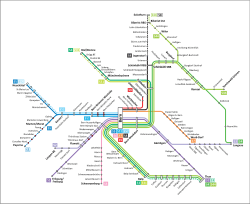Bern S-Bahn
The Bern S-Bahn (German: S-Bahn Bern; French: RER Berne) is an S-Bahn commuter rail network focused on Bern, the capital city of Switzerland. The network is roughly coterminous with Bern's urban agglomeration.
 | |||
A BLS S-Bahn train at Trubschachen | |||
| Overview | |||
|---|---|---|---|
| Locale | Bern, Switzerland | ||
| Transit type | S-Bahn | ||
| Number of lines | 13 | ||
| Daily ridership | 175,000 (weekdays) | ||
| Website | S-Bahn Bern (in German) | ||
| Operation | |||
| Began operation | 1974/1995 | ||
| Operator(s) | BLS AG Regionalverkehr Bern-Solothurn (RBS) | ||
| Technical | |||
| Track gauge | 1,435 mm (4 ft 8 1⁄2 in) (BLS) 1,000 mm (3 ft 3 3⁄8 in) (RBS) | ||
| |||
With approximately 9 million train kilometres per year, the Bern S-Bahn is the second-largest S-Bahn in Switzerland. It handles around 100,000 passengers daily (175,000 on weekdays), and thus carries the majority of the agglomeration's regional public transport traffic.
History
As early as 1974, Regionalverkehr Bern-Solothurn (RBS) began operating S-Bahn-style clock-face schedule services in the Bern area. Since 1987, the company has run a cross-city regional service between Thun and Laupen/Fribourg.
In 1995, RBS started to designate its regional services as S-Bahn services. The existing cross-city line was designated as S1, and the designation S2 was given to a new cross-city line, between Schwarzenburg and Trubschachen.
The next expansion occurred in 1997, with the commissioning of the S3 (Biel/Bienne−Belp) and the S4/S44 (Bern–Bümpliz Nord−Burgdorf and beyond). In addition, the remaining standard gauge regional train services were designated as the S33, S5, S51 and S55 lines.
Since the timetable change in December 2004, the RBS narrow gauge lines have been integrated into the S-Bahn numbering system as the S7, S8 and S9. Upon the 2008 timetable change, the network's interchange station arrangements were altered, the S11, S22 and S33 lines were shut down, and new lines S52 and S6 were opened.
Operations
The Bern S-Bahn Bern is operated, under a joint commission from the Canton of Bern, its neighbouring cantons and the Federal Government, by the following railway companies:
- BLS AG (BLS);
- Regionalverkehr Bern-Solothurn (RBS).
Upon the timetable change on 12 December 2004, the Swiss Federal Railways (SBB-CFF-FFS) withdrew from its previous involvement in the operation of the Bern S-Bahn, but also took over all of the long-distance services previously operated by the BLS.
Lines
As of December 2019, the network consists of the following lines. Unless otherwise stated, the lines are 1,435 mm or 4 ft 8 1⁄2 in standard gauge.[1]
| # | Route | Notes | Operator |
|---|---|---|---|
| S1 | Fribourg–Flamatt–Bern–Thun | BLS AG | |
| S2 | Laupen–Flamatt–Bern–Konolfingen–Langnau im Emmental | BLS AG | |
| S3 | Biel/Bienne–Bern–Belp | BLS AG | |
| S31 | Biel/Bienne–Bern–Belp | Rush-hour service | BLS AG |
| S4 | Thun–Belp–Bern–Burgdorf–Hasle-Rüegsau–Zollbrück–Langnau im Emmental | BLS AG | |
| S44 | Thun–Belp–Bern–Burgdorf–Solothurn/Hasle-Rüegsau–Zollbrück–Langnau im Emmental | Operates as a single train between Thun and Burgdorf[2] | BLS AG |
| S5 | Neuchâtel–Ins/Payerne–Murten/Morat–Kerzers–Bern Brünnen Westside–Bern | Operates as a single train between Neuchâtel and Kerzers[3] | BLS AG |
| S51 | Bern Brünnen Westside–Bern | BLS AG | |
| S52 | Ins–Kerzers–Bern Brünnen Westside–Bern | BLS AG | |
| S6 | Schwarzenburg–Bern | BLS AG | |
| S7 | Bern–Worb Dorf | Operates over the metre (3 ft 3 3⁄8 in) gauge Worb Dorf–Worblaufen line | RBS |
| S8 | Bern–Jegenstorf | Operates over the metre (3 ft 3 3⁄8 in) gauge Solothurn–Worblaufen line | RBS |
| S9 | Bern–Unterzollikofen | Operates over the metre (3 ft 3 3⁄8 in) gauge Zollikofen–Bern line | RBS |
Rolling stock
The normal rolling stock rosters for the Bern S-Bahn are:
- S1 BLS RABe 515 ("MUTZ"): up to two units per train (2 x 4- double-decker car EMU).
- S2 BLS RBDe 565 ("NPZ") with two "B6 Jumbo" intermediate cars.
- S3 BLS RABe 515 ("MUTZ"): up to two units per train (2 x 4- double-decker car).
- S31 BLS RABe 515 ("MUTZ")
- S4 BLS RBDe 565 or BLS RBDe 566 II ("NPZ") with "B6 Jumbo" and "B Lego" intermediate cars.
- S44 BLS RABe 525 ("NINA"): 4 cars EMU.
- S5 BLS RABe 525 ("NINA"): 1–3 units per train (3 cars EMU).
- S51 BLS RABe 515 ("MUTZ")
- S52 BLS RBDe 565 or RBDe 566 II
- S6 BLS RABe 515 ("MUTZ")
- S7 RBS Be 4/12 ("Mandarinli"): in peak times 2 x 4/12 (4 rounds),
- S7 supplementary trains Bern–Bolligen (2 rounds) Be 4/12 or ABe 4/12
- S8 RBS Be 4/12 ("Seconds"): 2 EMU per train.
- S9 RBS Be 4/12 ("Secondas")
References
- "Liniennetz S-Bahn Bern" (PDF). S-Bahn Bern (in German). 15 December 2019. Retrieved 23 May 2020.
- "S44: Thun–Belp–Bern–Burgdorf–Solothurn + Sumiswald-Grünen" (PDF). BLS AG. Retrieved 23 May 2020.
- "S5: Bern–Kerzers–Neuchâtel + Murten/Morat (–Payerne)" (PDF). BLS AG. Retrieved 23 May 2020.
See also
External links
| Wikimedia Commons has media related to Bern S-Bahn. |
- BLS – official site (in English)
- RBS – official site (in German)
- Network map – schematic as of 2014
